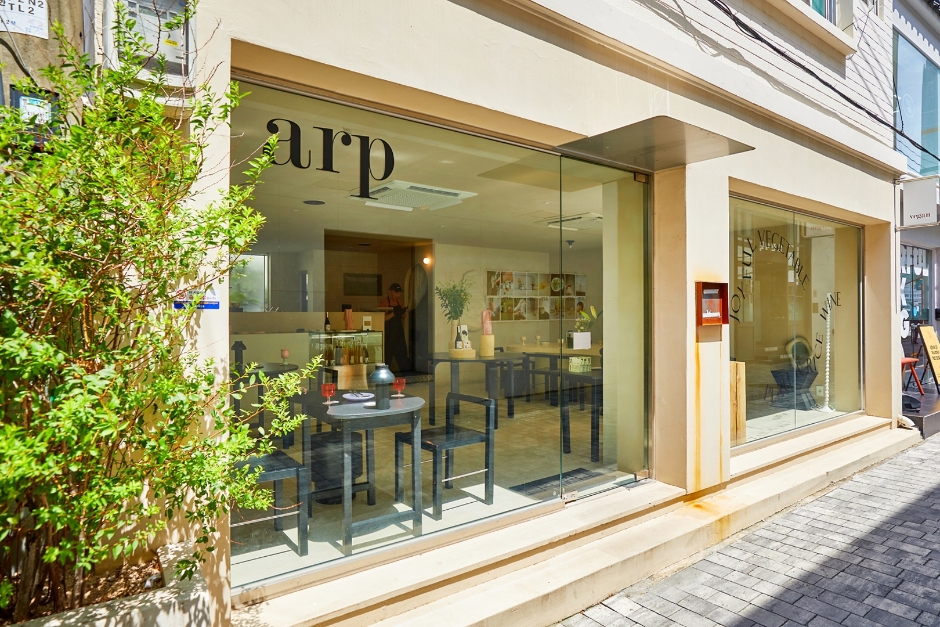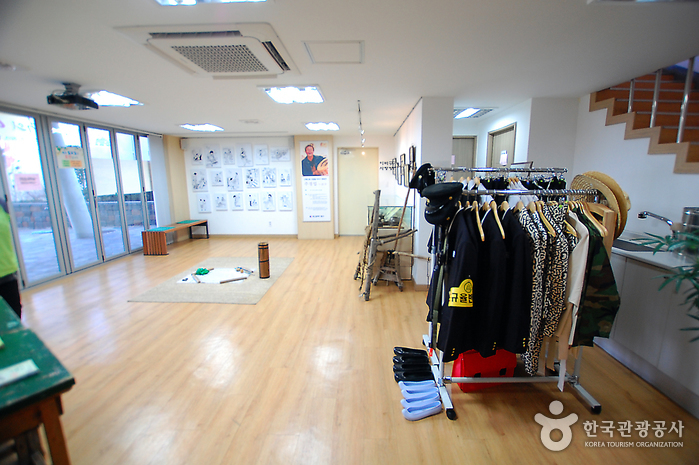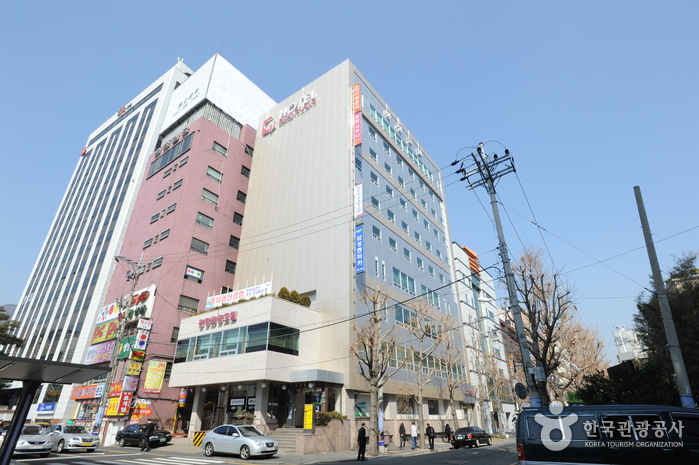Arp (아르프)
1.3Km 2024-01-05
35 Taejong-ro 99beon-gil, Yeongdo-gu, Busan
Located across from Samjin Food in Bongnae Market in Yeongdo-gu, Arp is a vegan restaurant famous as a place to take Instagrammable photos due to its streamlined and stylish interior. The recommended menu is Gosari Pasta, which has a delicious pesto made from brackens from Jirisan Mountain. The Arp Vegan Black Burger is filled with a plant-based patty, vegan cheddar cheese, lettuce, and tomato in a light and savory bun, making it a filling meal even for vegetarians. The signature menu here is rice liquor. The liquor is made using green tea leaves from Bongnaesan Mountain in Yeongdo, sticky rice, and malt, and is a perfect match with any menu. A variety of rice liquors are available, each crafted to offer a different experience for the taste buds by making slight changes using ingredients, fermentation, and seasonal characteristics. For example, Sunshine of You has a refreshing tart taste, while Lette uses lime to give a taste that suits the summer season.
Samjin Fish Cake History Museum · History Hall (삼진어묵체험·역사관)
1.3Km 2023-01-10
36, Taejong-ro 99beon-gil, Yeongdo-gu, Busan
+82-51-412-5468
Fish cakes are one of the most popular snacks in Busan. Among many fish cake makers in the city, Samjin Fish Cake is the oldest fish cake producer. Its main store in Yeongdo looks like a bakery shop. Visitors can choose among a variety of fish cakes and there is a separate space in the store where they can eat purchased fish cakes. The experience hall on the second floor provides a chance for visitors to make their own fish cake.
AREA6 (AREA6)
1.4Km 2023-02-03
37-3, Taejong-ro 105beon-gil, Yeongdo-gu, Busan
+82-1644-1593
AREA6 is a multipurpose cultural space made to promote the artisans and artists of Busan as a part of an urban regeneration project. On the first floor, there are a total of nine spaces, including F&B brands, select shops, and information centers. The second floor is a co-working space and lounge, and the third floor consists of a rooftop and seminar room that anyone can freely use. It was designed sensibly by keeping the existing buildng's shape without compromising volume and scale. Each space, such as a small alley that leads from the yard like a maze, is full of individuality and is fun to look around. Busan's local brands, such as Ineoajimae, Busan Drinks, and Samjin Fish Cake are located here, and a flea market is also held irregularly.
Olive Young - Busan Station Branch [Tax Refund Shop] (올리브영 부산역)
1.4Km 2024-04-18
1F, 197, Jungang-daero, Dong-gu, Busan
-
Himart - Yeongdo Branch [Tax Refund Shop] (하이마트 영도점)
1.5Km 2024-04-18
105, Taejong-ro, Yeongdo-gu, Busan
-
Provisional Capital Memorial Hall (임시수도기념관)
1.5Km 2021-04-16
45, Imsisudoginyeom-ro, Seo-gu, Busan
+82-51-231-6345
The Provisional Capital Memorial Hall was established on June 25, 1984. The memorial hall is significant for its role as the provisional government during the Korean War. The memorial hall was built in 1926 and it was used as the residence for the province governor of Gyeongsangnam-do. When the Korean War began in 1950, the building was repurposed to serve as the provisional government of Korea. Currently, the memorial hall is a great place to learn about Korean history because it contains the historical scenes of the provisional government during the Korean War. It contains exhibitions from the Korean War that display the everyday lives of civilians as well as the political, economic, and cultural aspects of the city of Busan.
Ebagu Crafts Workshop (이바구공작소)
1.6Km 2025-01-17
14-13, Mangyang-ro 486beon-gil, Dong-gu, Busan
+82-51-468-0289
Ebagu Crafts Workshop was created as part of an urban regeneration project centered along Sanbok Road. The workshop serves as an archive center for the stories of local residents in Sanbok Road, and a new planned exhibition is held every two months. Personal collections, as well as the history of locals living in this district are well preserved, creating a warehouse of cultural resources for the future.
* Opening Date: March 6, 2013
168 Stairs (168계단)
1.6Km 2023-01-03
9, Yeongcho-gil 197beon-gil, Dong-gu, Busan
+82-51-253-8253
This is the fastest way to go downhill from Sanbok road to Busan port. The stairs are known to be as tall as a 6-story building and have exactly 168 steps. In the past, there used to be 3 wells located at the bottom of the stairs, which locals would wait in line to draw water when there was insufficient water, but now, there is only one well with drinking water.
Hotel Gwangjang (광장호텔)
1.6Km 2025-01-07
7, Jungang-daero 214beon-gil, Dong-gu, Busan
+82-51-464-3141
Hotel Gwangjang is located near Busan Station Plaza in the heart of the port city Busan. The hotel underwent a major reconstruction work in 2002 to provide better quality rooms that offer both comfort and convenience. The hotel continues to provide excellent service to accommodate guests' needs.
CheongKwanJang - Busan Station Branch [Tax Refund Shop] (정관장 부산역)
1.7Km 2024-04-16
223-1, Jungang-daero, Dong-gu, Busan
-


![Olive Young - Busan Station Branch [Tax Refund Shop] (올리브영 부산역)](http://tong.visitkorea.or.kr/cms/resource/65/2885765_image2_1.jpg)
![Himart - Yeongdo Branch [Tax Refund Shop] (하이마트 영도점)](http://tong.visitkorea.or.kr/cms/resource/32/2890032_image2_1.jpg)



![CheongKwanJang - Busan Station Branch [Tax Refund Shop] (정관장 부산역)](http://tong.visitkorea.or.kr/cms/resource/62/2885762_image2_1.jpg)
 English
English
 한국어
한국어 日本語
日本語 中文(简体)
中文(简体) Deutsch
Deutsch Français
Français Español
Español Русский
Русский